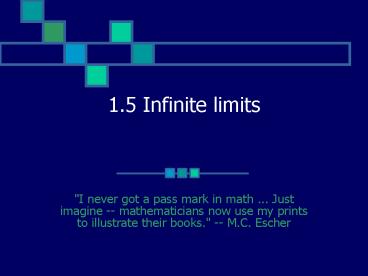1'5 Infinite limits - PowerPoint PPT Presentation
1 / 18
Title:
1'5 Infinite limits
Description:
Limit from the left is different than the limit ... of a vertical asymptote ... denominator and then check the numerator to see if it is a hole or an asymptote ... – PowerPoint PPT presentation
Number of Views:167
Avg rating:3.0/5.0
Title: 1'5 Infinite limits
1
1.5 Infinite limits
- "I never got a pass mark in math ... Just imagine
-- mathematicians now use my prints to illustrate
their books." -- M.C. Escher
2
Objective
- To describe infinite limits
3
Black holes
- Start with any number
- Count the number of even digits, the number of
odd digits, the total number of digits. - Write that 3-digit number
- Repeat
- Repeat
- Repeat
4
Ways limits DNE
- Limit from the left is different than the limit
from the right - Function increases or decreases without bound
- Function oscillates
5
Function increases or decreases without bound
- If both the left and the right side approach
infinity then - If both the left and the right side approach
negative infinity then
6
(No Transcript)
7
Discontinuities
- 2 types
- Removable
- Non-removable
8
Def. of a vertical asymptote
- If f(x) approaches infinity or negative infinity
as x approaches c from the right or left then the
line x c is a v. a. of the graph
9
V. A. theorem
- The functions f and g are continuous on an open
interval. If f(c) does not equal zero, g(c) 0,
and g(x) is not zero for all other x in the
interval then - has a v. a. at x c
10
In other words
- Look for zeros in the denominator and then check
the numerator to see if it is a hole or an
asymptote
11
Examples
12
More examples
13
Limits and V. A.
- Find
- What do you know about the function?
14
Left and right limits
15
Cont..
- Check from the left
- Check from the right
- The limit is
16
Properties of limits
- 1. Sum or difference
- 2. Product
17
More properties
- 3. Quotient
- These are also true for negative infinity
18
Practice problems






























